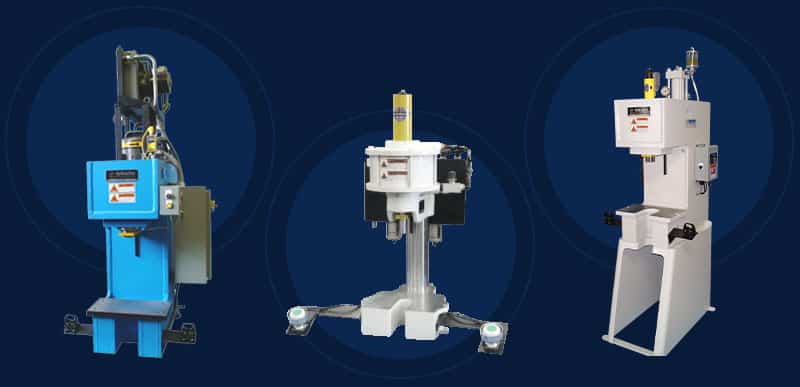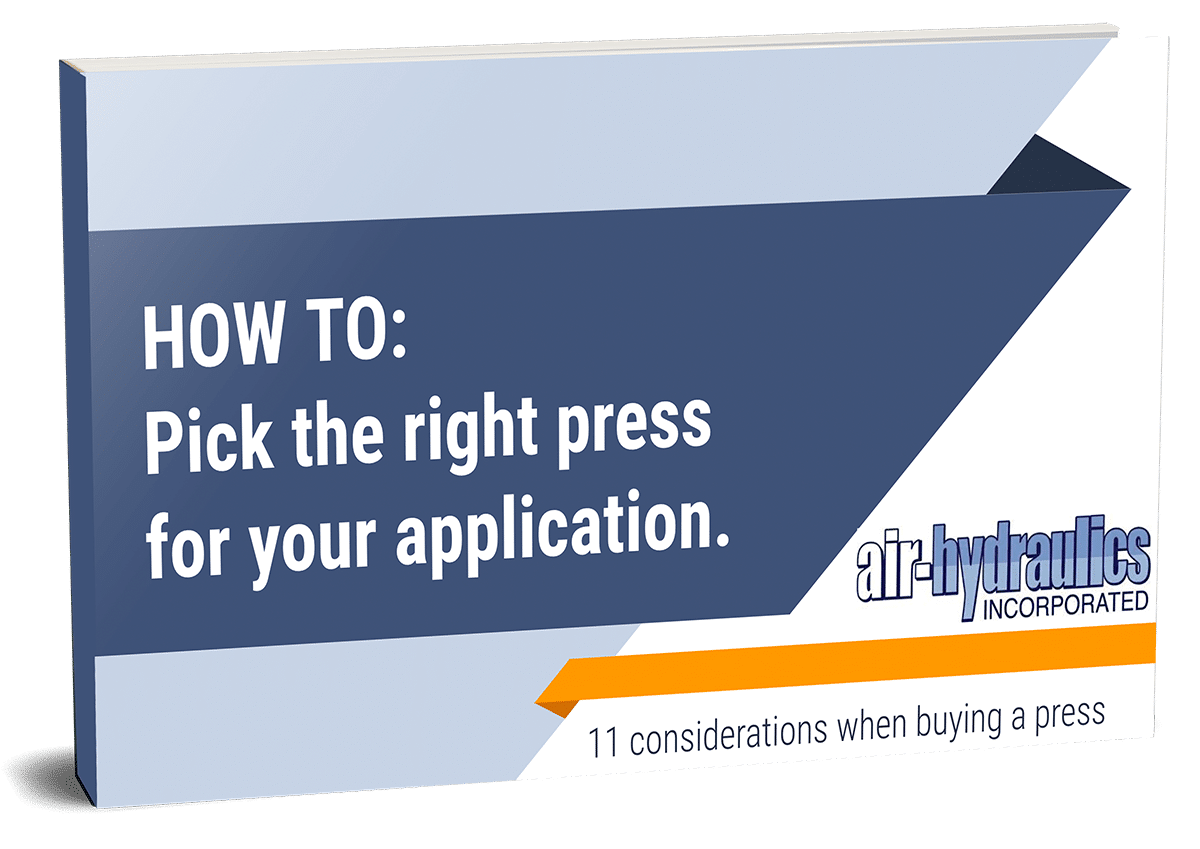
A shop press is a relatively simple machine, but it is essential to a wide variety of industries. From car parts and aircraft parts to plywood and ceramics to cheese and make-up and much more, many of the things we use everyday were formed, fabricated, stamped or compressed by a press. The two most common types of presses are a hydraulic press and a pneumatic press. But what’s the difference between a hydraulic press vs a pneumatic press? And why does it matter? And which do you need?
Hydraulic Press vs Pneumatic Press
What is a Hydraulic Press?
When comparing a hydraulic press vs a pneumatic press, it’s helpful to understand how each functions. So, what is a hydraulic press? How does it work? And how does a hydraulic press differ from a pneumatic press, in terms of functionality?
A hydraulic press uses pressurized liquid, usually a mineral oil, and a series of cylinders and pistons to create force. The liquid cannot be compressed, so it transfers the force to another cylinder and piston when force is applied. Cylinders and pistons of varying sizes working together creates a multiplicative effect, and can create an immense amount of force. This is, partly, why hydraulic systems drive some of the most powerful machines, such as bulldozers, cranes, and heavy-duty shop presses.
Get customized hydraulic presses for your shop
What is a Pneumatic Press?
So, what is a pneumatic press? And how is it different from a hydraulic press?
A pneumatic press uses gas instead of liquid to create force. While a hydraulic press uses hydraulic liquid in a series of cylinders, a pneumatic press uses pressurized gas from a compressor. This compressed gas may be regular air in the atmosphere (mostly nitrogen and oxygen) or pure nitrogen. When the gas is tightly squeezed into a small space, energy builds up between the moving molecules. This built-up potential energy turns into powerful kinetic energy when the gas is released. By controlling the airflow, the pneumatic system can then drive a device, like a pneumatic press.
Depending on the type of compressed air system used, the compressed air might provide pressure anywhere between 10psi and 5,000psi. A pneumatic system may be gentle enough to apply make-up to skin via airbrushing, or provide enough force to break concrete with a jackhammer. Just because it uses air instead of liquid doesn’t mean a pneumatic system is automatically less powerful than a hydraulic system.
Get high-efficiency, affordable pneumatic presses for your shop
What is a Hydropneumatic Press?
Interestingly, you don’t have to choose between a strictly hydraulic press or pneumatic press. A hydropneumatic press, AKA an air-over-oil press, actually combines pneumatic and hydraulic technology to create a maximal force with minimal maintenance and complexity.
In a hydropneumatic system, compressed air drives the piston that compresses the liquid in a hydraulic cylinder. This system gives the machine several advantages; the control and low-maintenance of a compressed air system, with the multiplicative power effect of a hydraulic system. A hydropneumatic press can be just as powerful as a purely hydraulic press, but the press has important safety features and cost advantages, which we’ll discuss in more detail later in the post.
Combine the power and efficiency of hydraulic and pneumatic presses
What’s the Difference Between a Hydraulic Press vs Pneumatic Press?
With the basics of a hydraulic press vs a pneumatic press understood, let’s take a closer look. What’s the difference between a hydraulic press and a pneumatic press when it comes to functionality, costs, and safety concerns?
Functionality and Force
Pneumatic Presses
- 150 to 5,000lbs of force
- Assembly
- Riveting
- Punching
- Marking
- Staking
- Stamping
- Crimping
- Forming
- Swaging
Hydropneumatic Presses
- Between 2.5 and 50 tons of force
- Bushing/bearing insertion
- Stud insertion
- Broaching
- Swaging
- Trimming
- Assembly
- Notching
- Joining
- Forming
- Fastening
Hydraulic Presses
- Up to 50 tons of force
- Bushing/bearing insertion
- Stud insertion
- Broaching
- Swaging
- Trimming
- Assembly
- Notching
- Joining
- Forming
- Fastening
As previously mentioned, both a hydraulic system and a pneumatic system can deliver plenty of force. A pneumatic press, AKA an air press, can deliver between 150 and 5,000lbs of force. This is suitable for many assembly, riveting, punching, marking, staking, stamping, crimping, forming, and swaging jobs.
A hydraulic press has a much higher force ceiling; it can deliver up to 50 tons (100,000 lbs) of press force. This extreme amount of force is generally only required when working with very tough materials. Hydraulic presses may be required for some bushing/bearing insertion, stud insertion, broaching, swaging, trimming, assembly, notching, joining, forming, or fastening jobs.
Hydropneumatic presses deliver the extreme force of a hydraulic press with many of the other advantages of a pneumatic press, such low maintenance costs, a smaller footprint, and quieter, safer operation. An AH Series air-over-oil press, for example, can deliver up to 50 tons of force during its power stroke, similar in assembly effectiveness as a purely hydraulic counterpart. This high level of versatility makes it suitable for nearly any of the previously mentioned jobs.
The biggest difference in force delivery between pneumatic and hydraulic is the more granular control of the ram on a hydraulic press. Due to how a full hydraulic press operates the operator can control the up and down motion at anypoint in the stroke and still have full power available to apply. A pneumatic operation typically requires the ram to return to the full up position between the use of its maximum specified force.
Costs and Maintenance
Pneumatic Presses
- Manufacturing grade air presses, like the 12-A and AP-400, start around $4,510 and $3,500, respectively.
- Requires shop air only.
- Requires basic mechanical maintenance and parts lubrication.
- Extremely durable, very few moving parts to cause issues.
Hydropneumatic Presses
- The C-400 10 ton press, which is comparable to most hydraulic presses, starts at about $12,500.
- Power by shop air with additional low voltage options.
- Requires mechanical maintenance, parts lubrication, and some fluid maintenance.
Hydraulic Presses
- Can be 3.5 times or more the cost of a similar in specification air over oil / hydropneumatic press
- Requires high-voltage power supply.
- Requires regular specialized maintenance for fluids, lubrication, motor, seals etc.
- More expensive to purchase and maintain long term.
A pneumatic press will almost certainly be cheaper to purchase, operate and maintain than a hydraulic press. This is partly because pneumatic presses utilize a simpler system. This means they are easier to manufacture, and therefore more affordable to purchase. A high-quality, lower force pneumatic shop press could be just a few thousand dollars, while a larger force hydraulic press will be many tens of thousands of dollars.
The relatively simple mechanics of pneumatic presses also means they are easier and cheaper to maintain. Repeatedly checking, maintaining and replacing fluid lines, bearings, bushings, oil reservoirs, coolant lines and more can be a cumbersome maintenance process for a hydraulic press. Contrastingly, the maintenance schedule for pneumatic systems and components is much easier.
Since a pneumatic press operates using compressed air, while a hydraulic press requires a high-voltage power supply, the operational costs of a pneumatic system are also lower. A hydropneumatic system will fall somewhere in between the two as far as price, maintenance costs, and operational costs.
Interested in learning more about how to select the right press for your application?
This free 30 page guide reviews 11 primary considerations when determining what press would be best for your business.
Safety and Training
Pneumatic Presses
- Uses hand safety controls to prevent injuries
- Quieter compressed air actuation only during press strokes
- Only requires shop air, options exist that may require other non high-voltage power supply.
Hydropneumatic Presses
- Uses hand safety controls to prevent injuries
- Quieter compressed air actuation only during press strokes
- Only requires shop air, options exist that may require other non high-voltage power supply.
Hydraulic Presses
- Uses hand safety control to prevent injuries
- Constant high decibel noise makes for a loud factory floor
- High-voltage power supply can create hazards
Our hydraulic presses, pneumatic presses, and hydropneumatic presses all come standard with dual hand safety controls to ensure that the operator is not interacting with the press while it’s active. Both presses are also ergonomically designed to help prevent repetitive stress injuries. Though all of these presses have the features and precautions to keep operators safe, there are some considerations that make a pneumatic press generally safer than a hydraulic press.
Though both presses should be used with hearing protection, a hydraulic press has a constant loud noise and can cause more issues with others in a factory as well as the operator’s hearing if they are not using proper protection, especially over a long time period. A hydraulic press also requires a high-voltage power supply, and damaged electrical lines, poor grounding, or faulty installation can impose electrocution and fire hazards. Petroleum-based hydraulic fluids and lubricants can also post fire hazards, especially if the machine is not properly maintained.
Whether you are using a pneumatic press, hydraulic press, or hydropneumatic press, it’s essential to fully understand all safety precautions and to perform a self assessment to determine if additional internal factory safety needs are required, in order to operate the machine properly, and to make sure it is properly maintained. With these precautions in place, you will be able to get the most out of your machine, and keep all staff members safe as well.
Browse Our Pneumatic, Air over Oil, and Hydraulic Presses

